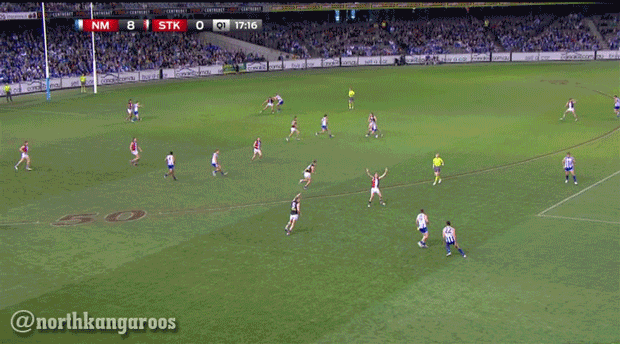In the first edition, we take an in-depth look at the importance of being an efficient team going inside the 50 metre arc.
A common refrain after AFL games normally follows the line of, ‘if we had made the most of our chances…’, or ‘we didn’t use the ball well going forward….’.
While disposal efficiency statistics can tell part of the story, it often doesn’t fully explain what happens when a team gets into a scoring position.
Heading into 2014, North Melbourne is positioned as one of the best sides in the competition at making the most of its forward 50 entries.
From an analytical point of view, inside 50 efficiency is easy to track:
- If North scores 50 times from 100 inside 50’s, its inside 50 score efficiency is 50 per cent.
- If North scores 20 goals from 100 inside 50’s, its inside 50 goal efficiency is 20 per cent.
Throughout 2013, three sides stood out for inside 50 and goal efficiency.
| Team | Inside 50 score efficiency (%) |
| Hawthorn | 44% |
| North Melbourne | 43.3% |
| Adelaide | 43.1% |
| Team | Inside 50 goal efficiency (%) |
| North Melbourne | 25.4% |
| Hawthorn | 25.1% |
| Geelong | 23.8% |
How important is the goal efficiency to clubs? The bottom seven sides in the rankings all finished outside the final eight.
Take it a step further and it shows Hawthorn, Geelong and Fremantle were all in the top five. It’s no coincidence those teams made up three quarters of preliminary final weekend.
North Melbourne was the anomaly, finishing in tenth place on the ladder despite being one of the most efficient sides going forward. It highlights the importance of finding the right balance between attack and defence.
Perhaps the Dockers are the most surprising side, as they were by no means considered an offensive juggernaut. However it does show the value of a well drilled side, making the most of its entries – Freo ranked just 15th for total inside 50 entries during 2013.
Often it’s what a side does without the ball which makes it dangerous close to goal. This snippet of play from North’s victory over St Kilda in Round 10 demonstrates exactly that.
As Ben Cunnington marks the ball 65 metres out from goal, the forward 50 looks congested. By the time the he decides to go long to Drew Petrie, the key-forward has a one-on-one at the top of the goal square, all due to off-ball movement.

Moving on to an individual level, the statistic can also show how players use the ball going inside 50 and the end result.
With silky-skilled players such as Brent Harvey and Daniel Wells in the side, the expectation would likely be for one of them to be at the top of North’s score and goal efficiency rankings. Instead, the results may surprise.
| Player | Inside 50 score efficiency (%) |
| Aaron Black | 55.8% |
| Brent Harvey | 53.8% |
| Nathan Grima | 53.6% |
| Player | Inside 50 goal efficiency (%) |
| Aaron Black | 37.2% |
| Aaron Mullett | 35.1% |
| Shaun Atley | 32.4% |
What this tells us is that when Black delivers the ball inside 50, North scores more than half the time, an astronomical number. Unsurprisingly this ranks top of the AFL amongst key forwards.
Mullett and Atley’s goal efficiency also has them in the top 10 among defenders in the league (minimum 25 inside 50’s).
Once the statistics are all collated, at the very top end inside 50 efficiency is almost a direct correlation to the heaviest scoring sides in the league.
Hawthorn, Geelong and North Melbourne scored the most points during 2013 and were also the top three sides in inside 50 goal efficiency.
Scoring clearly isn’t an issue for North, but restricting the damage going the other way is perhaps its biggest challenge in 2014.


